|
Bringing a Fender Squire Bullet back to life
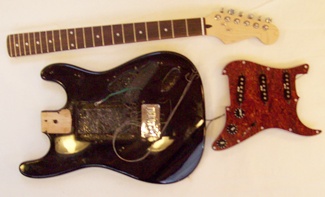
In case your not familiar, the Fender Squire Bullet is one of the least expensive electric guitars you can purchase. I see buy it now prices on crack bay for $110.00, all the time. And that's with a tremolo, mine didn't have a tremolo. As a footnote don't confuse the bullet with the Fender Squire Guitar, they're different. My Squire bullet was my first guitar, and served as the impetus for my current guitar obsession. It's been pillaged for parts over the last few years. The neck was used for a roller nut installation experiment, so that's not available. The pickups were destroyed in a botched wax potting experiment. What's left is the body, which I've been staring at in the basement for a year or so. I got to thinking that the first guitar I ever owned deserved a little more respect. So with a neck I had, a Mighty Mite loaded pickguard I bought on ebay for $42.00 plus shipping, and a few parts I've got kicking around, I decided to bring the Squire Bullet back from the dead. 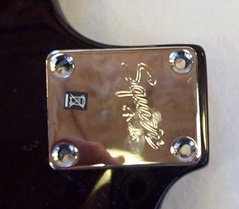
I hadn't looked at the Fender Squire Bullets body for awhile, and had forgotten that the neck plate holes were horribly out of line, right from the factory. You have to understand these guitars must be manufactured so fast to sell at this price point, I'm assuming They're literally thrown together. The body is one half inch thinner than a regular strat, and is laminated together much like plywood. In a way I'm glad I ran into this problem. You may be building a guitar, with a used neck, and discover the holes of the body, and the holes of the neck, are out of align, but are close enough so that you can't drill new holes. There is a solution, and for god sakes it's not wood filler. The local hardware store, or home improvement center, will have a wide range of wood dowels. Get a dowel that fits close, and cut as many pieces as holes needed to fill. Cut them a half inch longer than the depth of the hole(s). Cut a few more an inch or so in length, and with a utility knife, slice some wedge shaped pieces from the dowel pieces. Put some good wood glue on a piece of plastic, or Cheetos bag. Roll the full dowel in the glue then put it in the hole. Then roll a wedge in the glue and get that between the dowel and the hole. Drive the wedge in with a tack hammer, if you have a through hole, drive wedges in from both sides. Put as many wedges in as you can, and then let it set for 24 hours. 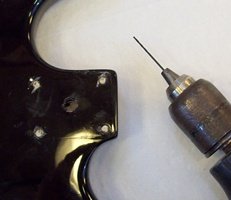
After the glue dries, cut the excess off as close to flush as possible with a pair of wire dikes. Then grind the dowel material down flush, using a dremel tool. If you don't have a dremel, surround the area with a few layers of painters tape to protect the finish, then sand flush with 100 grit sandpaper. I placed the neck plate where it's supposed to go, then used a center punch to align the drill bit. Note the picture above, you can see how out of align the holes were. With a drill, and a small drill bit, I used a 1/16" bit, drill out the pilot hole(s). If you don't have a through hole, wrap the bit with some tape as a depth gauge. I need to point something out before I continue. I do all my drilling with a cordless hand drill. I do this because I've done so much drilling, I feel comfortable that I can achieve a positive result. It would probably be wise to do this kind of drilling on a drill press. I even own a couple, the point is if you're nervous use a drill press, if you don't have one, find a friend with one, or take it to a wood shop. I try to do all my work with the least amount of specialty tools, things that most people have kicking around. 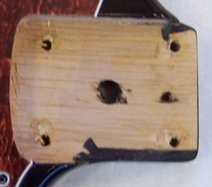
Once the pilot holes are drilled, don't switch to the bit size you need, unless it's only a few sizes up. I used five different bit sizes to gradually get to the hole size I needed. There is a real chance of going out of align if you jump too much in bit sizes, especially with a hand drill. Check out the picture to the left, if you look close, you can see the dowels, and the outline of the previous holes. Once the neck holes were set, I dry fit the neck. I discovered that the neck pocket was too deep. 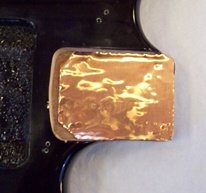
The neck that came stock with the Squire Bullet was a 21 fret neck. The 21 fret neck had a fingerboard that was flush with the heel. The new neck is a 22 fret neck. This neck has a finger board that runs past the heel, and over the pickguard, effectively hiding the seam between the neck and body. When I put the neck in the pocket, I realized the pickguard would not fit under the neck. So I used two pieces of heavy gauge copper foil in the pocket, to shim the neck up. I purchased a Fender Squire neck plate that came four screws.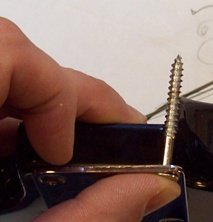 The body on my Fender Squire Bullet is 3/8" thinner than a standard strat, unlike the body on a Fender squire guitar, which is normal size. The screws that came with the neck plate we're made for a standard Stratocaster, and would pierce right up through the fingerboard, not a desirable result. Instead of running out, and trying to find some other screws, I cut them with a dremel tool, and ground the tips to a point.
The body on my Fender Squire Bullet is 3/8" thinner than a standard strat, unlike the body on a Fender squire guitar, which is normal size. The screws that came with the neck plate we're made for a standard Stratocaster, and would pierce right up through the fingerboard, not a desirable result. Instead of running out, and trying to find some other screws, I cut them with a dremel tool, and ground the tips to a point.This page was getting a little long in the tooth, so for the second half look at Bringing a Fender Squire Bullet back to Life, part two.
Return from Bringing a Fender Squire Bullet back to Life to Electric Guitar Info home |




